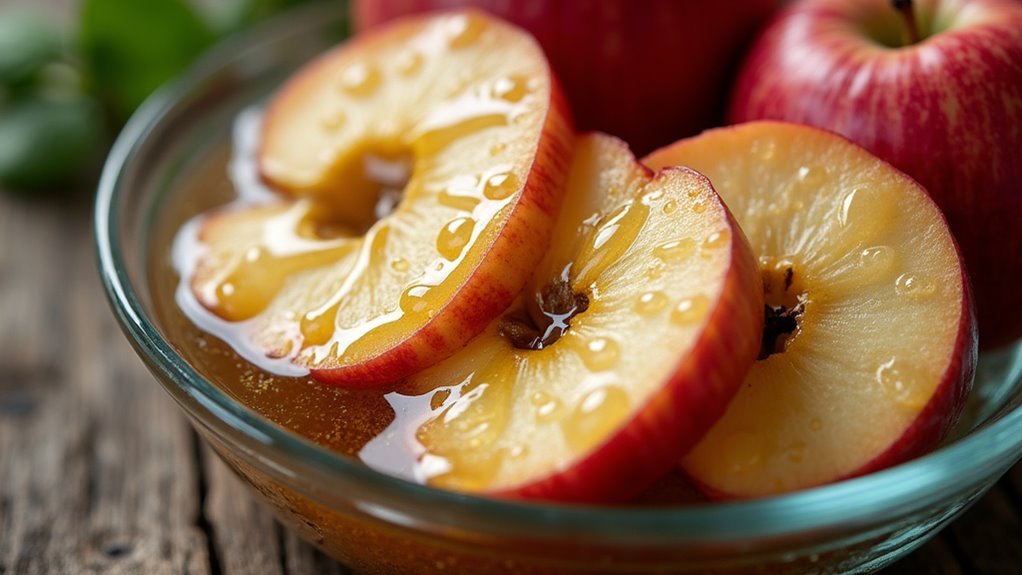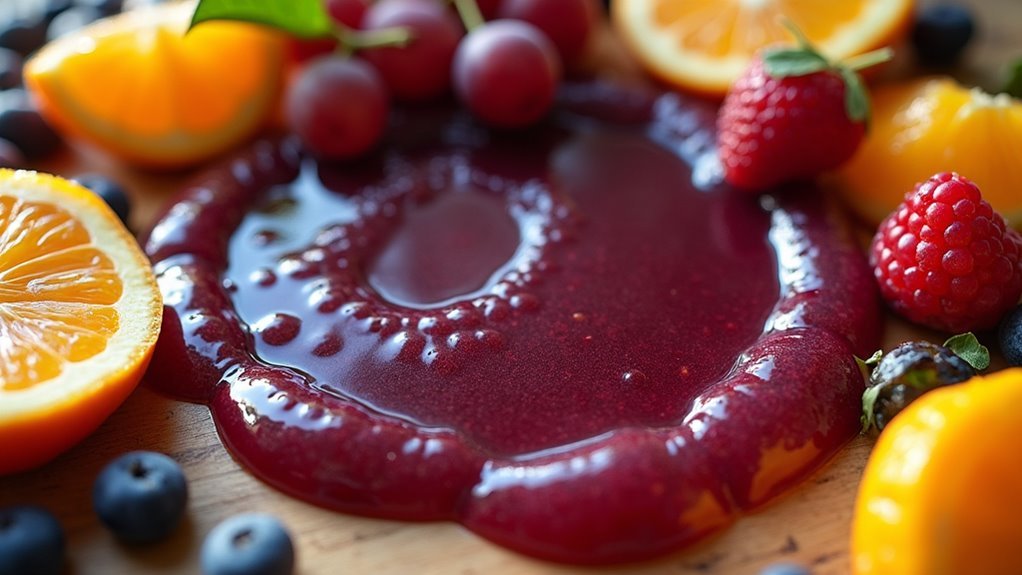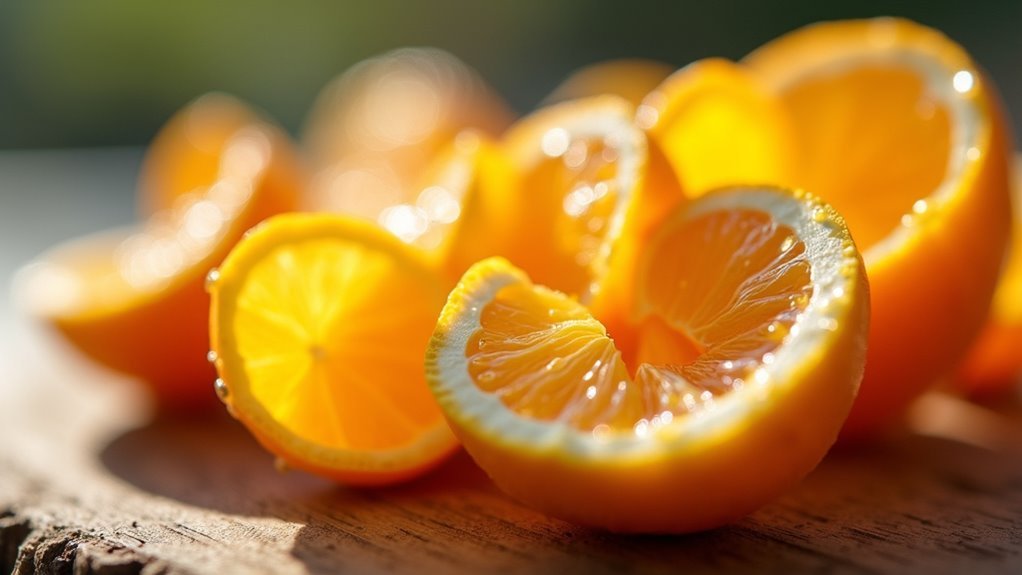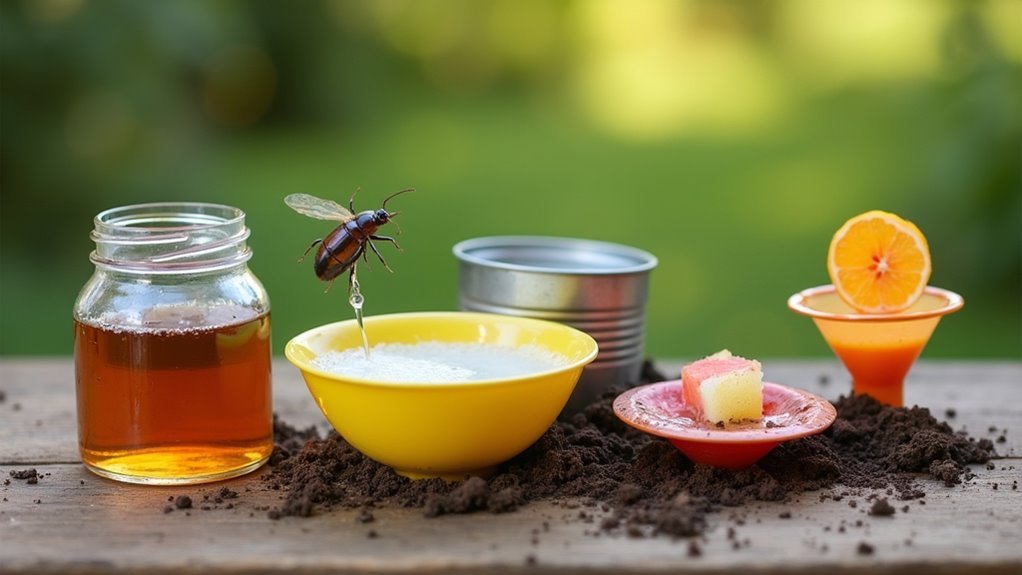You’ll find hornets irresistibly drawn to overripe apple slices mixed with sugar water, fermented strawberry-jam combinations, and rotting peach chunks in sweet syrup. Try grape juice with fruit pulp, mashed bananas combined with honey substitutes, or pear scraps mixed with apple cider for excellent results. Fig pieces soaked in concentrated nectar, melon rinds in sugary liquids, and citrus peels in fruit juice also prove highly effective. The key lies in understanding proper preparation techniques and strategic placement for maximum success.
Overripe Apple Slices With Sugar Water

When hornets become a persistent problem around your property, overripe apple slices combined with sugar water create one of the most effective baits you can use in traps. The strong scent and natural sugars in overripe apple slices make them irresistible to hornets.
Adding sugar water enhances the sweetness, dramatically increasing your trap’s appeal. You’ll want to use fresh apple slices since they produce the most potent aroma.
Fresh apple slices combined with sugar water create an irresistibly sweet aroma that dramatically boosts your hornet trap’s effectiveness.
Replace the bait regularly before it spoils and loses effectiveness. Position your trap in sunny areas where you’ve noticed hornet activity for ideal results.
This combination works because hornets can’t resist the intense sweet fragrance. The overripe apple slices and sugar water mixture consistently outperforms other bait options, making it your go-to solution for hornet control.
Fermented Strawberry and Jam Mixture
You’ll want to time your fermentation process for 2-3 days to develop the strongest aroma that hornets can’t resist.
Mix your overripe strawberries with jam at a 2:1 ratio, then add just enough water to create a pourable consistency.
This potent combination outperforms most other fruit baits because it targets hornets’ intensified sugar cravings during late season.
Fermentation Process Timing
Since timing determines the effectiveness of your fermented strawberry and jam bait, you’ll need to monitor the process carefully over 3-5 days.
During this fermentation process, sugars naturally break down into alcohol and acids, creating the potent scent that hornets find irresistible when they’re actively seeking sugars for their larvae.
You’ll know your bait is ready when it develops a strong, sweet-sour aroma. However, don’t let it ferment too long – over-fermentation creates excessive sourness that’ll actually repel hornets instead of attracting them.
Check your mixture daily after the third day, looking for that perfect balance of sweetness and fermentation.
For best results, deploy your fermented bait early in hornet season when they’re most actively foraging for both protein and sugars.
Strawberry Jam Ratios
The perfect fermented strawberry and jam mixture starts with getting your ratios right – approximately 2 parts jam to 1 part chopped overripe strawberries. This specific balance guarantees maximum scent release while maintaining the mixture’s consistency for effective hornet attraction.
Your strawberry jam mixture should follow these preparation guidelines:
- Use any sweet jam variety as your base ingredient
- Chop overripe strawberries into small, uniform pieces
- Combine ingredients in a clean, sealed container
- Allow 2-3 days at room temperature for fermentation
- Monitor regularly and replenish when potency decreases
This ratio capitalizes on hornets’ preference for sweet, fruity odors during late summer feeding periods.
The fermentation process amplifies the aroma, making your strawberry jam bait irresistible to these insects seeking sugary food sources.
Effectiveness Against Hornets
Field tests consistently demonstrate that fermented strawberry and jam mixtures outperform traditional hornet baits by remarkable margins.
You’ll notice considerably higher capture rates when using this combination, especially during late summer when hornets desperately seek sugary foods. The fermentation process creates irresistible aromas that draw hornets more effectively than standard fruit juice baits.
Your trapping success will improve dramatically with overripe strawberries mixed with jam. The sweet, fruity scents produced during fermentation generate additional compounds that hornets find particularly appealing.
You’ll see a notable decrease in hornet activity around your fruit crops once you deploy these enhanced traps.
This potent bait mixture consistently delivers superior results compared to conventional options, making it an essential tool for protecting your agricultural yields from hornet damage.
Rotting Peach Chunks in Sweet Syrup
Among the most potent hornet baits you’ll find, rotting peach chunks combined with sweet syrup create an irresistible lure that draws these insects from considerable distances.
The fermentation process produces an intense aroma that hornets can’t resist, especially during late summer and early fall when they’re actively seeking sugary food sources.
To maximize effectiveness with rotting peach chunks:
- Simmer water and sugar to create your sweet syrup base
- Mix decomposing peach pieces thoroughly with the syrup
- Place mixture in well-ventilated traps for ideal freshness
- Monitor bait regularly to prevent excessive drying
- Replace when chunks become overly decomposed
This combination exploits hornets’ natural sugar cravings while the fermentation scent acts as a powerful long-distance attractant for your traps.
Grape Juice and Fruit Pulp Combination

When hornets begin their intense late-season sugar hunt, grape juice mixed with fruit pulp creates a devastatingly effective trap bait that’ll outperform many commercial alternatives.
The grape juice mimics overripe fruit sugars that hornets desperately seek during late summer and early fall. Adding fruit pulp enhances the mixture’s appeal by providing texture and concentrated sweetness that draws hornets from greater distances.
You’ll want to dilute this combination with water to prevent it from becoming overly concentrated or messy while maintaining its attractiveness. The key is finding the right balance between potency and practicality.
Remember to monitor your traps regularly and replenish the grape juice mixture, especially after rainfall. Fresh bait maintains maximum effectiveness, ensuring your hornet control efforts remain successful throughout the entire trapping season.
Mashed Banana With Honey Substitute
You’ll find that mashing ripe bananas with agave syrup or sugar-water creates an irresistible hornet bait that won’t attract beneficial bees.
Mix the banana thoroughly until it forms a smooth paste, then add your honey substitute in a 2:1 ratio for maximum effectiveness.
Position your baited traps 10-15 feet from outdoor dining areas and refresh the mixture every 2-3 days before it spoils.
Preparation and Mixing Tips
Since ripe bananas provide the perfect base for hornet bait, you’ll want to mash them thoroughly until they reach a smooth, uniform consistency. This preparation guarantees maximum attractiveness to hornets while creating an easy-to-apply mixture.
Follow these essential mixing guidelines:
- Mash bananas completely to eliminate lumps and create smooth texture
- Add honey substitute gradually while mixing to achieve proper sweetness
- Maintain moisture levels to prevent rapid drying in traps
- Test different ratios to find what works best in your area
- Prepare fresh batches regularly as banana mixture ferments quickly
You’ll achieve excellent results by experimenting with banana-to-honey ratios since local hornet preferences vary.
Keep the mixture moist enough to remain effective but thick enough to stay in place within your traps.
Optimal Placement Strategy
After preparing your mashed banana and honey substitute mixture, strategic trap placement becomes essential for maximizing hornet captures.
Position your fruit-baited traps in sunny locations where hornets naturally gravitate toward warmth and light. Hang them approximately 1.5 meters above ground in trees or shrubs, aligning with typical hornet flight patterns while ensuring maximum visibility.
Keep traps 6-7 meters away from areas where people gather, effectively drawing hornets away from outdoor spaces. Monitor trap effectiveness every few days, relocating them closer to known hornet nests if activity remains low.
Remember to refresh your banana bait regularly since diminishing scent reduces attraction power. Moving traps strategically based on hornet behavior patterns will considerably improve your capture rates and overall success.
Citrus Peel Soaked in Fruit Juice

One surprisingly effective hornet trap bait combines citrus peel with fruit juice to create a powerful attractant that draws these pests away from your outdoor spaces.
When you use citrus peel soaked in fruit juice, you’re leveraging the natural sugars that hornets crave, especially during late season when they’re actively seeking sweet substances.
To maximize your trap’s effectiveness with this bait:
Maximize your hornet trap’s effectiveness by following these simple preparation and maintenance steps for optimal results.
- Soak fresh orange or lemon peels in fruit juice for several hours
- Replace the bait regularly to maintain its potent scent
- Use citrus-based fruit juices for enhanced attraction
- Place soaked peels directly in your trap’s collection area
- Refresh weekly or when the scent diminishes
This method repurposes food scraps while specifically targeting hornets rather than beneficial pollinators, making it an environmentally conscious choice.
Pear Scraps Mixed With Apple Cider
The intoxicating combination of pear scraps mixed with apple cider creates a powerfully aromatic bait that hornets find irresistible, particularly during their late-season sugar-seeking frenzy. The fermentation process intensifies the cider’s appeal, while pear’s natural sugars and fruity scent amplify the attraction.
| Preparation Step | Method | Time Required |
|---|---|---|
| Choose Pear Type | Use fresh or overripe scraps | 5 minutes |
| Mix Ingredients | Combine scraps with apple cider | 2 minutes |
| Allow Fermentation | Let mixture sit undisturbed | 2-4 hours |
| Deploy in Traps | Place mixture in hornet traps | 5 minutes |
You’ll achieve maximum effectiveness by allowing the mixture to intensify before deployment. Regular replenishment maintains potency, especially after rainfall affects your hornet traps.
Fig Pieces in Concentrated Fruit Nectar
You’ll find that selecting ripe figs and cutting them into small, aromatic pieces creates an irresistible base for your hornet trap bait.
Concentrating fruit nectar through gentle heating or reduction amplifies the sugar content that draws hornets from considerable distances.
Strategic trap placement near hornet flight paths, combined with proper ventilation, guarantees your fig-nectar combination maintains peak effectiveness throughout the trapping period.
Fig Selection and Preparation
When selecting figs for hornet traps, you’ll want to choose specimens that are fully ripe but not overripe, as they contain the perfect sugar concentration that attracts these insects.
Proper fig selection and preparation maximizes your trap’s effectiveness. Look for ripe fruit that’s soft to the touch but still holds its shape. Overripe figs become mushy and lose their appeal to hornets.
Follow these preparation steps for best results:
- Cut figs into small, manageable chunks to increase surface area
- Remove any damaged or moldy portions before cutting
- Expose the flesh to release natural sugars and aromas
- Combine pieces with concentrated fruit nectar for enhanced attraction
- Replace bait every few days to maintain freshness
Deploy your prepared fig bait during early morning or late afternoon when hornet activity peaks.
Nectar Concentration Techniques
Although fresh fig pieces provide natural attraction, concentrating their nectar greatly amplifies your trap’s effectiveness. You’ll create a powerful bait by combining fig pieces with diluted fruit nectar or sugar water, forming a potent attractant mixture that hornets can’t resist during their late-summer sugar-seeking behavior.
Use overripe figs for maximum sugar concentration, as they’re considerably more appealing than fresh varieties. Mix both fresh and slightly fermented fig pieces to leverage decomposing scents that draw hornets from greater distances. The fermentation process releases concentrated sugars and enhanced aromatic compounds.
Remember to refresh your fig pieces regularly since their effectiveness diminishes as they dry out or lose scent. This maintenance guarantees your nectar concentration remains at peak potency for the best hornet capture rates.
Trap Placement Strategies
Three critical factors determine your trap’s success rate with fig pieces and concentrated nectar: location, distance, and height.
You’ll want to place your traps in sunny areas where hornets naturally forage, as they’re attracted to warmth and light when seeking sweet food sources.
Position your traps strategically using these guidelines:
- Distance: Keep traps 6-7 meters from human activity areas
- Height: Hang at 1.5 meters above ground in trees or shrubs
- Location: Choose sunny spots that mimic natural food sources
- Monitoring: Check and refill regularly with fresh trap bait
- Variety: Test different fruit-based baits to determine effectiveness
This placement mimics hornets’ natural feeding patterns while keeping them away from your outdoor spaces.
Regular maintenance guarantees your trap bait remains potent and continues attracting hornets throughout late summer and fall.
Plum Fragments With Berry Juice Blend
Since hornets shift their dietary preferences from proteins to sugars as summer progresses into fall, plum fragments combined with berry juice create an irresistible dual-appeal bait.
You’ll find this combination particularly effective during late summer and early fall when hornets actively seek both protein sources and sugary substances.
Mix plum fragments with raspberry or blueberry juice to enhance sweetness and aroma, creating a potent attractant.
Combine fresh plum pieces with raspberry or blueberry juice for maximum sweetness and aromatic appeal to targeting hornets.
The natural sugars in berry juice draw hornets efficiently during their dietary shift period. This strategic blend appeals specifically to hornets while minimizing attraction to beneficial pollinators, reducing unintended captures.
You’ll need to refresh your plum and berry juice mixture regularly to maintain high capture rates.
Fresh, potent baits consistently outperform stale alternatives in attracting hornets to your traps.
Melon Rinds in Sugary Liquid Base
When hornets enter their sugar-seeking phase, melon rinds soaked in sugary liquid bases become exceptionally effective trap baits. The natural sugars and high moisture content in melons create an irresistible combination that draws hornets, particularly during late season when they’re actively seeking sugar sources.
To maximize effectiveness with melon rinds and sugary liquids, follow these preparation steps:
- Cut melon rinds into smaller, manageable pieces
- Soak pieces in sugar water, fruit juice, or soda
- Allow flavors to meld for enhanced attractiveness
- Place traps in sunny, wind-protected locations
- Monitor and replace bait regularly to prevent degradation
You’ll need to replenish this bait frequently since melon rinds degrade quickly in warm weather.
Position your traps strategically away from competing food sources to guarantee hornets choose your bait over alternatives.
Frequently Asked Questions
What Is the Best Bait for Hornet Traps?
You’ll get best results using sweet liquids like apple juice or grape soda during late summer. For early season, try protein sources like smoked turkey. Rebait weekly and avoid excessive vinegar.
What Fruit Juice Attracts Wasps the Best?
You’ll find grape soda works exceptionally well for attracting wasps, especially late in the season. Diluted apple juice also proves highly effective due to its sweet content and appealing fragrance that draws them in consistently.
What Attracts Hornets to a Trap?
You’ll attract hornets using sweet liquids like apple juice, grape soda, or beer during late summer. Early season, they prefer protein baits like meat scraps. Refresh your bait regularly since rain dilutes effectiveness.
What Sweet Liquid Attracts Wasps?
You’ll attract wasps effectively with apple juice, grape soda, sugar water, or beer. Old jam mixed with water works excellently too. Add vinegar to deter bees while keeping wasps interested in your trap.
In Summary
You’ll find success with these fruit-based baits by rotating them regularly and placing traps away from areas where you spend time. Don’t forget to check your traps every few days and refresh the bait when it’s no longer attracting hornets. Remember, you’re targeting specific pests, so be patient and consistent. With the right fruit combination and proper placement, you’ll greatly reduce hornet populations around your property this season.





Leave a Reply